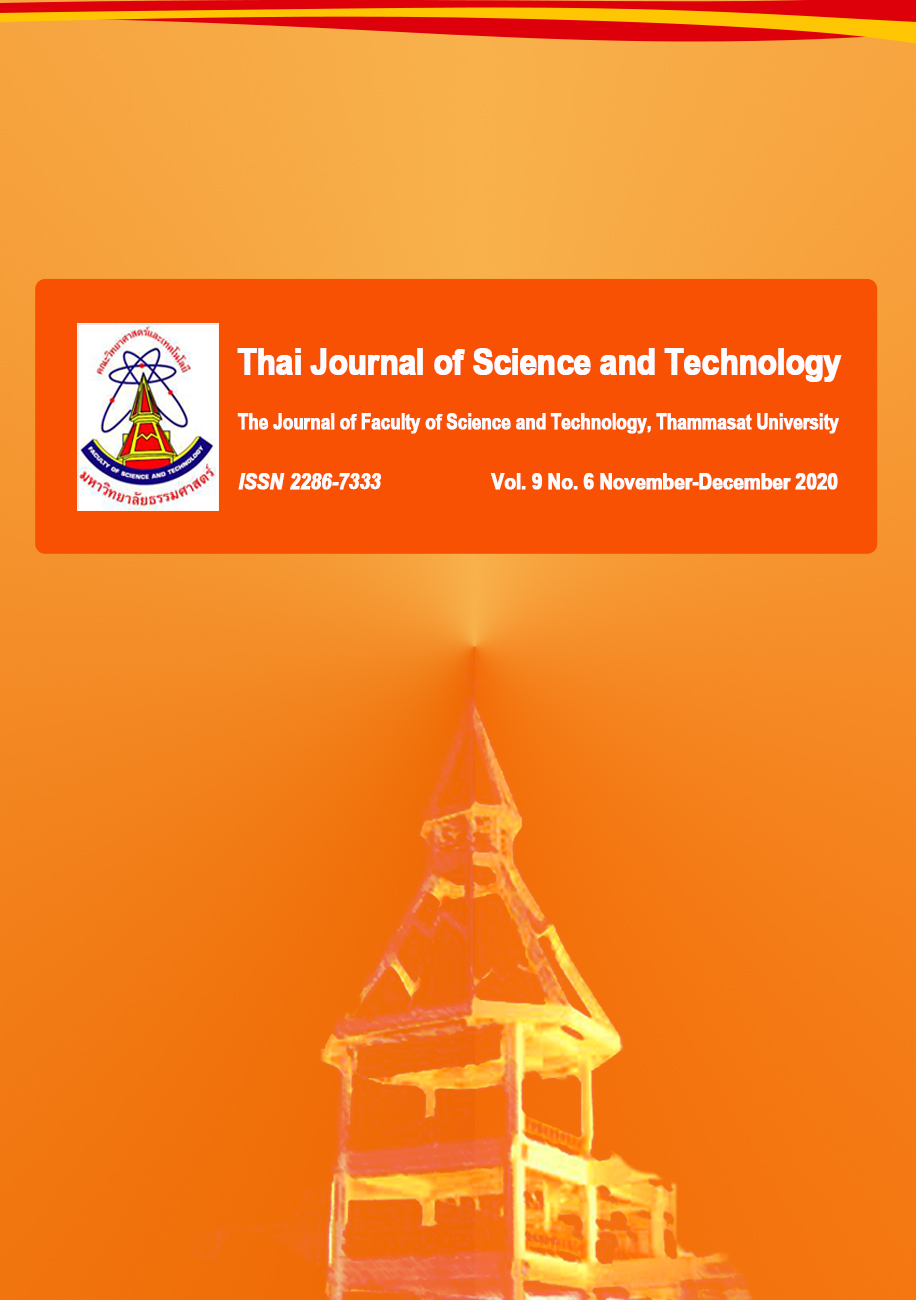การพัฒนาชีวภัณฑ์ไตรโคเดอร์มาชนิดเม็ดเพื่อการควบคุมโรคเหี่ยวเหลืองของมะเขือเทศ
Main Article Content
Abstract
This research aimed to develop a Trichoderma-based granular bioproduct to extend the product’s shelf life and control Fusarium oxysoprum f.sp. lycopersici (Fol). Factorial in CRD was used for experimental design. There were three factors, including encapsulated granule formulations, storage temperature, and storage time. Each formulation contained conidia of Trichoderma sp. and sodium alginate, but the concentration of glycerol and tapioca starch was varied. The products were stored at room temperature and 4 ºC from 1 to 9 months. The results showed that the viability of Trichoderma sp. from each formulation was significantly different. Storage temperature at 4 ºC provided higher viability than room temperature. The F1 formulation (sodium alginate 0.88 % + glycerol 1.5 %) provided the best result, the highest quantity of survived conidia, at room temperature storage. The amount of survived conidia was stable for 5 months of storage. F3 (sodium alginate 0.88 % + tapioca starch 1.5 %), F4 (sodium alginate 0.88 % + glycerol 1.5 % + tapioca starch 1.5 %), F5 (sodium alginate 0.88 % + glycerol 1.5 % + tapioca starch 3.7 %), and F6 (sodium alginate 0.88 %) formulations provided the highest number and stable of survived conidia at 4 ºC up to 9 months. The survived Trichoderma sp. from all formulations maintained the Fol inhibitory ability.
Article Details
บทความที่ได้รับการตีพิมพ์เป็นลิขสิทธิ์ของคณะวิทยาศาสตร์และเทคโนโลยี มหาวิทยาลัยธรรมศาสตร์ ข้อความที่ปรากฏในแต่ละเรื่องของวารสารเล่มนี้เป็นเพียงความเห็นส่วนตัวของผู้เขียน ไม่มีความเกี่ยวข้องกับคณะวิทยาศาสตร์และเทคโนโลยี หรือคณาจารย์ท่านอื่นในมหาวิทยาลัยธรรมศาสตร์ ผู้เขียนต้องยืนยันว่าความรับผิดชอบต่อทุกข้อความที่นำเสนอไว้ในบทความของตน หากมีข้อผิดพลาดหรือความไม่ถูกต้องใด ๆ
References
Benitez, T., Rincon, A.M., Limon, M.C. and Codon, A.C., 2004, Biocontrol mechanisms of Trichoderma strains, Int. J. Microbiol. 7: 249-260.
Charoenrak, P. and Chamswarng, C., 2016, Efficacies of wettable pellet and fresh culture of Trichoderma asperellum biocontrol products in growth promoting and reducing dirty panicles of rice, Agric. Nat. Resour. 50: 243-249.
Czene, K., Lichtenstein, P. and Hemminki, K., 2002, Environmental and heritable causes of cancer among 9.6 million individuals in the Swedish family-cancer database, Int. J. Cancer 99: 260-266.
Ha, T.N., 2010, Using Trichoderma species for biological control of plant pathogens in Vietnam, J. ISSAAS 16: 17-21.
Jurić, S., Đermić, E., Topolovec-Pintarić, S., Bedek, M. and Vinceković, M., 2019, Physicochemical properties and release characteristics of calcium alginate microspheres loaded with Trichoderma viride spores, J. Integr. Agric. 18: 2534-2548.
Küçük, Ç. and Kıvanç, M., 2005, Effect of formulation on the viability of biocontrol agent, Trıchoderma harzıanum conidia, Afr. J. Biotechnol. 4: 483-486.
Locatelli, G.O., Santos, G.F., Priscila, S. Botelho, P.S., Finkler, C.L.L. and Bueno, L.A., 2018, Development of Trichoderma sp. Formula tions in encapsulated granules (CG) and evaluation of conidia shelf-life, Biol. Control 117: 21-29.
Manandhar, S., Pant, B., Manandhar, C. and Baidya, S., 2019, In vitro evaluation of bio-control agents against soil borne plant pathogens, J. Nepal Agric. Res. Counc. 5: 68-72.
Mishra, P.K. and Khan, F.N., 2015, Effect of different growth media and physical factors on biomass production of Trichoderma viride, People’s J. Sci. Res. 8: 11-16.
Munoz-Celayaa, A.L., Ortiz-García, M., Vernon-Carter, E.J., Jauregui-Rincón, J., Galindo, E. and Serrano-Carreón, L., 2012, Spray-drying microencapsulation of Trichoderma harzianum conidias in carbohydrate polymers matrices, Carbohydr. Polym. 88: 1141-1148.
Navaneetha, T., Prasad, R.D. and Venkateswar, R.L., 2015, Liquid formulation of Trichoderma species for management of gray mold in castor (Ricinus communis L.) and alternariaster leaf blight in sunflower (Helianthus annuus L.), J. Biofertil. Biopestici. 2015: 6.
Sharpe, R.M. and Irvine, D.S., 2004, How strong is the evidence of a link between environmental chemicals and adverse effects on human reproductive health, BMJ 328: 447-451.
Singh, V., Upadhyay, R.S., Sarma, B.K. and Singh, H.B., 2016, Trichoderma asperellum spore dose depended modulation of plant growth in vegetable crops, Microbiol. Res. 193: 74-86.
Skidmore, A.M. and Dickinson, C.H., 1976, Colony interactions and hyphal interference between Septoria nodurum and phylloplane fungi, T. Brit. Mycol. Soc. 66: 57-64.
Sousa, K.A., Junior, G.S.F., Lima, K.T.L., Pinto, G.A.S., Aguiar, R.S.S. and Azevedo, D.C.S., 2014, Evaluation of the use of raw glycerol in biomass production by Trichoderma reesei QM9414, BMC Proc. 8(Suppl 4): P173.


